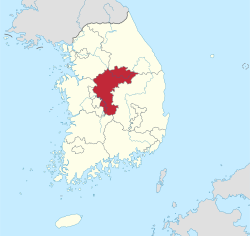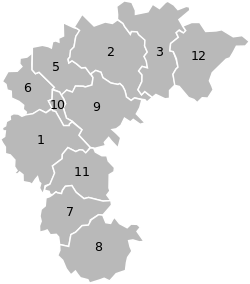محافظة تشونگتشنگ الشمالية
North Chungcheong Province
충청북도 | |
|---|---|
| Chungcheongbuk-do النطق الكوري: [tɕʰuŋ.tɕʰʌŋ.buk̚.t͈o] | |
| الترجمة اللفظية بالـ Korean | |
| • Hangul | 충청북도 |
| • Hanja | 忠淸北道 |
| • McCune‑Reischauer | Ch’ungch’ŏngbukto |
| • Revised Romanization | Chungcheongbuk-do |
 | |
| الإحداثيات: 36°45′N 127°45′E / 36.750°N 127.750°E | |
| Country | |
| Region | Hoseo |
| Capital | Cheongju |
| Subdivisions | 5 مدن؛ 8 مقاطعات |
| الحكومة | |
| • المحافظ | Kim Young-hwan (People Power) |
| المساحة | |
| • الإجمالي | 7٬433 كم² (2٬870 ميل²) |
| ترتيب المساحة | 8th |
| التعداد (October, 2014)[1] | |
| • الإجمالي | 1٬578٬934 |
| • الترتيب | 7th |
| • الكثافة | 213/km2 (550/sq mi) |
| Metropolitan Symbols | |
| • Flower | White Magnolia |
| • Tree | Zelkova |
| • Bird | Magpie |
| GDP | |
| • Total | KR₩ 79 trillion US$ 63 billion (2022) |
| ISO 3166 code | KR-43 |
| Dialect | Chungcheong |
| الموقع الإلكتروني | Official website (English) |
محافظة تشونگتشنگ/تشونغتشنغ الشمالية (بالكورية: 충청북도، Chungcheongbuk-do), also known as Chungbuk, is a province of South Korea. North Chungcheong has a population of 1,578,934 (2014) and has a geographic area of 7,433 km2 (2,870 sq mi) located in the Hoseo region in the south-center of the Korean Peninsula. North Chungcheong borders the provinces of Gyeonggi and Gangwon to the north, North Gyeongsang to the east, North Jeolla to the south and South Chungcheong, Sejong Special Autonomous City and Daejeon Metropolitan City to the west.
Cheongju is the capital and largest city of North Chungcheong, with other major cities including Chungju and Jecheon.
North Chungcheong was established in 1896 from the province of Chungcheong, one of the Eight Provinces of Korea, consisting of the northeastern half of the territory, and is South Korea's only landlocked province. North Chungcheong was known as Chūsei-hoku Prefecture during the Japanese Colonial Period from 1910 and became part of South Korea following the division of Korea in 1945.
. . . . . . . . . . . . . . . . . . . . . . . . . . . . . . . . . . . . . . . . . . . . . . . . . . . . . . . . . . . . . . . . . . . . . . . . . . . . . . . . . . . . . . . . . . . . . . . . . . . . . . . . . . . . . . . . . . . . . . . . . . . . . . . . . . . . . . . . . . . . . . . . . . . . . . . . . . . . . . . . . . . . . . . .
Geography
The province is part of the Hoseo region, and is bounded on the west by Chungcheongnam-do province, on the north by Gyeonggi-do and Gangwon-do provinces, on the south by Jeollabuk-do province, and on the east by Gyeongsangbuk-do. Chungcheongbuk-do is the only land-locked province in South Korea. The province is mostly mountainous, dominated by the Noryeong Mountains to the north and the Sobaek Mountains to the east.
السكان
| Year | Pop. | ±% p.a. |
|---|---|---|
| 1980 | 1٬424٬083 | — |
| 1990 | 1٬389٬686 | −0.24% |
| 2000 | 1٬466٬567 | +0.54% |
| 2010 | 1٬512٬157 | +0.31% |
| 2015 | 1٬589٬347 | +1.00% |
| 2020 | 1٬632٬088 | +0.53% |
| Source: Citypopulation[3] | ||
Resources
Agricultural products includes rice, barley, beans, and potatoes, but the province specializes in ginseng and tobacco. The tobacco was introduced from the US in 1912, transplanted from Virginia.
There are mineral reserves of gold, iron, coal, steatite, fluorite, and molybdenum, as well as marble and limestone in the northern part of the province. Silk weaving plays an important role.
Attractions
The main attractions in the province are Mount Songni (1,058 metres [3,471 ft]) in the Sobaek mountains and its national park. Beopjusa, the site of one of the oldest temples of Korea is located in this national park, as is Guinsa, the headquarters of the Cheontae sect. There is another national park around Mount Worak.
Administrative divisions
Chungcheongbuk-do is divided into 3 cities (si) and 8 counties (gun). Each entity is listed below in English, Hangul, and Hanja.
| Map | # | Name | Hangul | Hanja | Population (2012)[4] | Subdivisions |
|---|---|---|---|---|---|---|

| ||||||
| — Specific City — | ||||||
| 1 | Cheongju | 청주시 | 淸州市 | 845,325 | 4 ilban-gu — 3 eup, 10 myeon, 30 haengjeong-dong | |
| — City — | ||||||
| 2 | Chungju | 충주시 | 忠州市 | 208,404 | 1 eup, 12 myeon, 12 haengjeong-dong | |
| 3 | Jecheon | 제천시 | 堤川市 | 137,612 | 1 eup, 7 myeon, 9 haengjeong-dong | |
| — County — | ||||||
| 5 | Eumseong County | 음성군 | 陰城郡 | 92,581 | 2 eup, 7 myeon | |
| 6 | Jincheon County | 진천군 | 鎭川郡 | 63,344 | 1 eup, 6 myeon | |
| 7 | Okcheon County | 옥천군 | 沃川郡 | 53,337 | 1 eup, 8 myeon | |
| 8 | Yeongdong County | 영동군 | 永同郡 | 50,732 | 1 eup, 10 myeon | |
| 9 | Goesan County | 괴산군 | 槐山郡 | 37,705 | 1 eup, 10 myeon | |
| 10 | Jeungpyeong County | 증평군 | 曾坪郡 | 34,194 | 1 eup, 1 myeon | |
| 11 | Boeun County | 보은군 | 報恩郡 | 34,500 | 1 eup, 10 myeon | |
| 12 | Danyang County | 단양군 | 丹陽郡 | 31,334 | 2 eup, 6 myeon | |
الدين
Religion in Chungcheongbuk-do (2015)[5]
According to the 2015 census, 16.3% of the population follows Buddhism and 23.1% follow Christianity (15.8% Protestantism and 7.3% Catholicism). 59.9% of the population is not religious and 0.7% of the population follows other religions.[5]
Education
Chungcheongbuk-do is the site of several tertiary institutions, including:
- Chungbuk National University
- Korea National University of Transportation (formerly Chungju National University)
- Korea Air Force Academy
- Korea National University of Education
- Cheongju National University of Education
- Cheongju University
- Seowon University
- Semyung University
- Far East University
- Youngdong University
- Chung Cheong College
- Jusung College
- Daewon Science College
- Konkuk University
- Gangdong College
References
- ^ "연령별 인구현황". Archived from the original on 2014-11-29. Retrieved 2015-10-01.
- ^ "2022년 지역소득(잠정)". www.kostat.go.kr.
- ^ "South Korea: Provinces" (in الإنجليزية).
- ^ "Population". Chungcheongbuk-do. September 2012. Retrieved 2013-06-07.
- ^ أ ب "2015 Census – Religion Results".
. . . . . . . . . . . . . . . . . . . . . . . . . . . . . . . . . . . . . . . . . . . . . . . . . . . . . . . . . . . . . . . . . . . . . . . . . . . . . . . . . . . . . . . . . . . . . . . . . . . . . . . . . . . . . . . . . . . . . . . . . . . . . . . . . . . . . . . . . . . . . . . . . . . . . . . . . . . . . . . . . . . . . . . .
External links
 North Chungcheong travel guide from Wikivoyage
North Chungcheong travel guide from Wikivoyage- Official website (in إنگليزية)
- Pages using gadget WikiMiniAtlas
- صفحات بها مخططات
- Short description is different from Wikidata
- Articles containing كورية-language text
- Coordinates on Wikidata
- Articles with hatnote templates targeting a nonexistent page
- Articles with إنگليزية-language sources (en)
- North Chungcheong Province
- Provinces of South Korea

